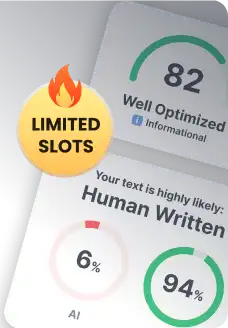Sitelinks are additional links that appear below a search result, provided by a website, to help users quickly navigate to specific pages within that website, improving the user experience and potentially boosting click-through rates for those search results.
These links are typically generated automatically by search engines based on the website’s structure and what the search engine deems most relevant to the user’s query. However, website owners can influence the generation of sitelinks by maintaining a clear and organized website structure, using descriptive page titles, and creating a sitemap.
Not every website will have sitelinks, and their appearance can vary depending on the search query and the search engine’s algorithms. The goal is to make it faster and easier for users to find the specific information they’re looking for within a website, directly from the search results page.
Key Takeaways
- Sitelinks show up under any site’s main search result. More importantly, from a user experience standpoint, they save users from having to hunt down vital internal pages. They can be performance enhancing, joint financing rewarding, fiscal sustainability improving, and user experience rewarding!
- While Google algorithmically generates sitelinks, it does so based on your site structure, content relevance, and user behavior. A cleanly organized site that does a good job of internally linking almost guarantees the sitelinks showing up.
- Sitelinks improve user navigation by reducing clicks needed to access key content. They help navigation, save users time and effort in the search process, and are a more effective way for users to find information.
- We’ve seen that websites displaying sitelinks generally enjoy a much higher click-through rate. These enriched sitelinks create enhanced search results. Users find them more appealing and engaging, which increases organic traffic.
- Optimizing for sitelinks involves actions like creating descriptive title tags, submitting a sitemap to Google Search Console, implementing structured data markup, and ensuring intuitive site navigation.
- To make the most of sitelinks, monitor sitelink performance on a regular basis through tools such as Google Search Console. Track metrics like click-through rates and user behavior to adjust your approach and get the most out of your sitelinks.
What Are Sitelinks?
Sitelinks are additional links that appear below a search result, designed to enhance the user experience. When users perform a search, and a relevant website appears in the search results, sitelinks provide quick access to specific, often important, pages within that website.
This direct navigation helps users find the information they need faster, without having to navigate through the website’s general homepage. By offering these direct pathways, sitelinks improve the overall interaction quality, or user experience, by streamlining the search process.
Sitelinks can lead to a significant boost in click-through rates, as users are more likely to engage with a website when they can easily access the specific content they are looking for. They serve as shortcuts within a search result, guiding users directly to the most pertinent pages of a website.
Types of Sitelinks Explained
Sitelinks are extra links shown under a main search result, meant to help users get the information they’re looking for more quickly and easily. These links fall into two categories: organic sitelinks and paid sitelinks.
Organic vs Paid
Organic sitelinks are automatically generated sitelinks. Paid sitelinks, or sitelink extensions, are customizable assets that can be built into paid search advertising campaigns. They both have specific use cases, but both are equally important to get more visibility and better direct users to relevant content.
Organic Sitelinks: How They Appear
Organic sitelinks are those that get created automatically by Google’s algorithm based on website relevance, structure, and user behavior. They usually show up beneath ranking #1 organic results for websites that are considered authorities in their field.
So, for example, a university site might show sitelinks to its admissions, academic programs, and campus services pages. These links are very dynamic, always shifting to align with what users are searching for most and what’s trending.
Of course, we know that Google favors sites that are well-structured. To improve your odds of earning organic sitelinks, employ easy-to-follow navigation menus, informative anchor text, and a clear hierarchy. You can’t control their appearance directly, but optimizing your site structure ensures better chances of visibility.
Sitelink Extensions: Control and Customization
Aside from regular organic sitelinks, there are sitelink extensions, which are paid assets that advertisers can add to Google Ads campaigns. These links take users directly to pages like a current promotion or a page with a contact form helping the ad to perform stronger.
For instance, an e-commerce site advertisement could showcase the sale items or their shipping policy in the sitelinks. Setting up sitelink extensions in Google Ads involves specifying URLs and descriptions, ensuring each link is concise (50-60 characters) to avoid truncation.
Using these sitelinks extensions boosts click-through rates and gives users faster access to more useful information.
Understanding Search Box Sitelinks
Search box sitelinks give users the ability to search a website straight from the search results page. This feature not only provides convenience but also increases user engagement.
To get this feature, you need to have the required structured data markup and a working internal site search engine. For instance, a large national news site may add a search box sitelink, allowing users to find articles on a certain topic or person easily.
This cultivates an experience of interactivity that saves the user’s time and enhances the overall usability of the site. Making sure your search engine is returning accurate results is the biggest step in making this feature useful.
Benefits of Implementing Sitelinks
Sitelinks are a clean and intuitive method to improve your site’s visibility and usability right inside search engine results. Providing comprehensive information about your site’s content, they cut through the clutter, making navigation easier, users happier, and engagement deeper.
Enhanced Website Usability
User experience enhancers sitelinks complement your website’s navigational aids. They bring users directly to relevant pages, such as product categories, service pages, or FAQs, without extra clicks.
When implemented correctly, sitelinks can help reduce user frustration by allowing users to find the most relevant pages more quickly and efficiently. For example, a user searching for a clothing retailer might immediately see “Men’s Apparel” or “Sale Items” linked below the main result.
This strategy goes a long way toward minimizing bounce rates. When users have more clicks leading them to exactly what they are looking for, their overall satisfaction tends to increase, improving their user experience.
Improved Click-Through Rates (CTR)
Sitelinks even enriches search results by providing a more attractive listing with relevant links that fulfill search user intent. This maximizes the chance of click throughs because now users have more options tailored to their intent.
Higher CTRs don’t just bring more traffic to your key pages; they look great to search engines and can help improve those rankings over time. For instance, a blog with sitelinks to its most popular articles can attract more clicks, signaling strong engagement to search engines and supporting overall performance.
Increased Brand Trust and Authority
Therefore, when you have sitelinks, it gives an impression of trustworthiness. Users view any site that’s awarded sitelinks to be well-structured, established, and trustworthy.
This enhances brand visibility as well as builds consumer trust. For companies, this credibility can lead to lasting customer loyalty.
Better Mobile Search Experience
Want to try SurgeGraph for free?

Generate 20 documents

SEO tools (Auto Optimizer, Internal Linking, and more)

No credit card required
Sitelinks appeal to mobile users, as they provide fast links to important pages, meeting their needs of how they browse on a mobile device.
When optimized, sitelinks deliver deeper engagement and remove friction, creating higher mobile conversion satisfaction.
How Google Generates Sitelinks
Sitelinks are one of the most valuable and eye-catching features in search results, providing searchers with immediate links to important pages within a website right in SERPs. Google determines these algorithmically by looking at your site structure, content relevance, and user behavior. That’s an automated process driven by the idea that the best user experience possible is served by showing the most useful links for any given query.
Navigation clarity, internal linking, and user engagement metrics are key considerations. In fact, Google has stated that humans decide when and which pages are shown as sitelinks.
Google’s Algorithm and Sitelinks
Google’s algorithms digest the content of each website to figure out the most relevant and useful sitelinks. Factors like page traffic, relevance to keyword, and content hierarchy play a role in this selection. Sitelinks are more likely to show on pages with good user engagement.
They satisfy the highest level of user intent by being the most visited. Finally, user interaction data, including CTR, helps further tweak these decisions, so sitelinks best fit what searchers are looking for. A well-structured and fast site with great technical SEO goes a long way in meeting these algorithmic requirements.
Monitoring news about changes in Google’s algorithms is key to recalibrating strategies to retain or achieve improved sitelink visibility.
Factors Influencing Sitelink Generation
While some factors like having a clear site hierarchy and writing original, useful content are the best way to guarantee sitelinks, they can’t be directly requested. A logical and obvious hierarchy in your navigation will help Google see what pages are most important.
Internal linking helps out with this by telling bots which pages to send users to first. Indirect metrics like user engagement signal value, affecting placement. One example is that schema usage can help inform your sitelink preferences, but Google’s logic will differ.
Website Structure and Sitelink Relevance
Having a logical and user-friendly website structure is key to having the most relevant sitelinks. Breadcrumbs, extensive menus, and clear navigation help Google understand which pages are important and should be emphasized.
Websites that have a clear, crawlable structure are more easily crawled, allowing sitelinks to be generated more readily.
How to Solve Missing Sitelinks
Missing sitelinks can be frustrating. While Google ultimately controls their generation, you can improve your chances by addressing key site elements.
1. Use Descriptive Title Tags
Creating concise and relevant title tags goes without saying. These tags let Google know what your pages are most relevant for, as well as allowing users to quickly recognize what’s on the page.
For instance, instead of naming a page “Recipes Page,” you could come up with a more descriptive title, like “Best Vegan Recipes for Beginners.” Make sure each title reflects what the page is about and what the users want to find, using targeted keywords and your brand name if it makes sense.
Well-optimized title tags will help your chances of gaining sitelinks and are simply better for overall SEO.
2. Submit a Sitemap to Search Console
Submitting an XML sitemap in Google Search Console will ensure that your preferred site structure is more easily understood by the search engines. Though this doesn’t have a direct impact on Sitelinks, it does help to make sure important pages are indexed correctly and efficiently.
Making sure the sitemap file stays current enhances crawling and indexing. This allows Google to best prioritize your most relevant pages.
3. Create Compelling Internal Links
Additionally, internal links to your site act as a map of sorts, helping Google and users navigate your site to the most important pages. You can use descriptive anchor text as a way to build relationships between semantically relevant content.
For instance, using internal anchor text like “Learn SEO Basics” to link to your ultimate beginner’s guide helps that page rank and provides better site navigation.
4. Implement Structured Data Markup
Using structured data markup, such as schema, allows search engines to better understand the content on your site. Though not an absolute surety, using structured data on important pages can go a long way to making sitelinks a reality.
Test it, this is the most important step. Use tools such as Google’s Structured Data Testing Tool to test your markup.
5. Improve Site Architecture and Navigation
At the end of the day, a clear, intuitive site architecture is key. Logical, hierarchical structures keep users and search engines on the path, ensuring a smooth journey through your site.
Perform a regular audit of your navigation flow for aesthetics, usability and to make sure the most critical pages are still easily accessible.
6. Focus on Branded Keyword Strategy
Optimizing your site for sitelinks goes beyond being visible only for branded keywords. Use your brand name to build recognition and trust.
Use your brand name in title tags, headings, and other prominent places to better reinforce your branding. For instance, “Smith’s Bakery: Freshly Baked Goods” highlights branding while appealing to searchers.
Monitor Sitelink Performance
Sitelinks contribute significantly to enhancing user navigation and boosting website visibility, but their effectiveness depends on consistent evaluation and refinement. By keeping a close eye on sitelink performance, you can help them to better fit your campaign goals and user intent.
Want to try SurgeGraph for free?

Generate 20 documents

SEO tools (Auto Optimizer, Internal Linking, and more)

No credit card required
Track Sitelink Metrics in Search Console
Google Search Console is a great free resource for monitoring sitelink performance. To view this data, head to the Search Performance report and filter for sitelinks. Key metrics to watch are impressions, estimated clicks, and CTR’s (click-thru-rates).
For instance, if a sitelink receives high impressions but low clicks, it may signal a need for better alignment with user intent. You can find sitelink performance data in Google Ads under the ad extensions dashboard. Google Analytics helps you get campaign-specific insights by letting you enable secondary dimensions such as Campaign.
These metrics help you find trends in user intent. They indicate which of your sitelinks receive the most interaction, allowing you to focus and optimize your strategy.
Analyze User Behavior on Sitelinked Pages
Knowing how users are engaging with sitelinked pages can help. Metrics such as average time on page and bounce rates provide a glimpse into whether the page content is aligned with what users expect.
For instance, if visitors are bouncing right away, that’s an indication that the content on that page isn’t doing its job. Understanding these behaviors helps you optimize navigation and create seamless user experiences, leading to higher engagement and retention.
Refine Your Sitelink Strategy Based on Data
Constant data-driven adjustments are crucial to truly refining sitelinks. For instance, tailor sitelinks according to CTR trends or direct user input to boost relevance.
Continuous evaluation ensures your sitelinks stay effective, flexible, and aligned with evolving user needs, creating better outcomes for your campaigns.
Common Sitelink Mistakes to Avoid
Sitelinks are vital for improving the user experience and dramatically increasing your click-through rate (CTR). According to Google, when used correctly, sitelinks can increase your CTR up to 30%. Common mistakes can sap their power, so it’s important to do these things the right way.
Over-Optimization and Keyword Stuffing
Over-optimization is when sites go overboard with who links to them and what those anchors say, sometimes even resulting in awkward phrasing. For example, repeating the same keyword like “best running shoes” in every link signals manipulative intent and risks penalization under Google’s algorithms, which are increasingly adept at catching such strategies.
Your goal should be seamless and organic, descriptive yet varied, user-focused language that helps them navigate their next steps. Avoid Private Blog Networks (PBNs). Search engines catch on quickly, and links calling for just dofollow backlinks are spammy.
Prioritizing genuine link-building protects your brand’s credibility and reduces the risk of future penalties.
Ignoring Mobile Sitelink Experience
With as much as 60% of web traffic coming from mobile devices, not optimizing for mobile leaves a huge segment of potential users unengaged. Mobile users will have a different experience in terms of navigation, as they need shorter, clearer options that are quick and easy to tap.
When sitelinks get too tiny or misaligned, users are less likely to engage. Consistent mobile testing helps ensure your internal and external links are working properly and showing the most relevant information to users, avoiding missed opportunities.
Neglecting Site Speed and Performance
Slow-loading pages can quickly make sitelinks a waste of time, with a high bounce rate leaving users high and dry. Changes such as optimizing page speed by compressing images or enabling caching benefit SEO and overall user experience and engagement.
Conducting regular audits can catch issues before they become a nightmare for users.
Frequently Asked Questions
What are sitelinks?
Sitelinks are those extra links you see below a website’s main search result on Google. They allow users to jump straight to the most important pages on your site, which makes for happier users and increased visibility.
How does Google decide which sitelinks to display?
Google’s sitelinks algorithms automatically create these sitelinks with consideration given to your site structure and user behavior on the SERP. Logical navigation and high-quality, relevant content will help increase your site’s chances of Google showing sitelinks for your site.
Why are sitelinks important for SEO?
Sitelinks help increase your click-through rate, allow users to navigate their search more effectively, and lend quality to your site. They can help you stand out in search results, attracting more qualified traffic to your most important pages.
Can I manually create sitelinks?
No, sitelinks are a Google algorithmically generated feature. Optimizing your site structure, navigation, and internal linking can increase the likelihood of sitelinks appearing.
How can I optimize my site for sitelinks?
Implement a flat site architecture, meaningful internal link anchor text, and a simple internal linking scheme. Make sure your site works great on mobile and you’re creating the type of content your target audience wants to find.
What are common mistakes that prevent sitelinks from appearing?
A cluttered site structure, intentional duplicate content, and confusing navigation can all stop sitelinks from appearing. Optimize out broken links and make sure your website provides a user experience that’s smooth sailing.
How do I monitor my sitelink performance?
Monitor sitelink impressions, clicks, and overall performance with Google Search Console. Consistent monitoring will show where you can improve site structure and where you can engage more users to find your content.





